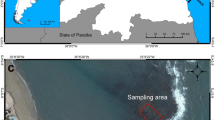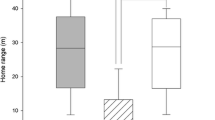Abstract
Territories are often aggregated. Because of this, distance to neighbours should influence how territory-holders balance safety from predators with the use and defence of resources. I examined the influence of distance to a neighbour on refuge use by pairs of convict cichlids (Archocentrus nigrofasciatus) faced with a conflict between hiding and defending food patches. Neighbours could reduce the rate of intrusions by strangers as a by-product of their own resource defence. This should allow fish with near neighbours to spend more time in the refuge. Neighbours could also steal from patches that are left undefended. This should lead to a reduction in use of the refuge. When one fish was confined to its refuge (so that its patch was undefended), theft by the other increased as inter-patch distance decreased. Distance between patches did not influence the rate of intrusion by non-territorial fish. When both fish defended patches, body mass influenced the effect of inter-patch distance on refuge use. Large fish rarely used the refuge, but small territory-holders spent more time in the refuge when patches were close together, as predicted. However, when one fish was dominant at both patches, distance between patches did not influence refuge use. These results suggest that, despite increased opportunity for theft, there is no realised foraging or defensive benefit to settling near neighbours that are of similar competitive ability.




Similar content being viewed by others
References:
Barlow GW (1993) The puzzling paucity of feeding territories among freshwater fishes. Mar Behav Physiol 23:155–174
Bednekoff PA (2002) On hotshots and lotteries: are the best males on larger leks better than expected? Behav Ecol 13:580–581
Beehler BM, Foster MS (1988) Hotshots, hotspots, and female preference in the organization of lek mating systems. Am Nat 131:203–219
Breau C, Grant JWA, (2002) Manipulating territory size via vegetation structure: optimal size of area guarded by the convict cichlid (Pisces: Cichlidae). Can J Zool 80:376–380
Chapman LJ, Bevan DJ. (1990) Development and field evaluation of a mini-spaghetti tag for individual identification of small fishes. Am Fish Soc Symp 7:101–108
Diaz-Uriarte R (1999) Anti-predator behaviour changes following an aggressive encounter in the lizard Tropidurus hispidus. Proc R Soc Lond, B 266:2457–2464
Dill LM, Fraser AHG (1997) The worm returns: hiding behavior of a tube-dwelling marine polychaete, Serpula vermicularis Behav Ecol 8:186–193
Dill LM, Gillett JF (1991) The economic logic of barnacle Balanus glandula (Darwin) hiding behavior. J Exp Mar Biol Ecol 153:115–127
Godin JGJ (1997) Evading predators. In: JGJ Godin (ed) Behavioural ecology of teleost fishes. Oxford University Press, Oxford, pp 191–236
Grand TC, Dill LM (1999) The effect of group size on the foraging behaviour of juvenile coho salmon: reduction of predation risk or increased competition? Anim Behav 58:443–451
Grand TC, Grant JWA (1994) Spatial predictability of food influences its monopolization and defence by juvenile convict cichlids. Anim Behav 47:91–100
Grant JWA, Girard IL, Breau C, Weir LK (2002) Influence of food abundance on competitive aggression in juvenile convict cichlids. Anim Behav 63:323–330
Hart DD (1987) Feeding territoriality in aquatic insects: cost-benefit models and experimental tests. Am Zool 27:371–386
Höglund J, Alatalo RV (1995) Leks. Princeton University Press, Princeton, N.J.
Koivula K, Lahti K, Rytkönen S, Orell M (1994) Do subordinates expose themselves to predation? J Avian Biol 25:178–183
Komdeur J (2001) Mate guarding in the Seychelles warbler is energetically costly and adjused to paternity risk. Proc R Soc London. B. 268:2103–2111
Lima SL, Dill LM (1990) Behavioral decisions made under the risk of predation: a review and prospectus. Can J Zool 68:619–640
Norris DR, Stutchbury BJM (2001) Extraterritorial movements of a forest songbird in a fragmented landscape. Conserv Biol 15:729–736
Stamps JA (1988) Conspecific attraction and aggregation in territorial species. Am Nat 131:329–347
Temeles EJ (1994) The role of neighbours in territorial systems: when are they ‘dear enemies’? Anim Behav 47:339–350
Tobias J, Seddon N (2000) Territoriality as a paternity guard in the European robin, Erithacus rubecula. Anim Behav 60:165–173
Turner GF, Pitcher TJ (1986) Attack abatement: a model for group protection by combined avoidance and dilution. Am Nat 128:228–240
Webster MS, Chuang-Dobbs HC, Holmes RT (2001) Microsatellite identification of extrapair sires in a socially monogamous warbler. Behav Ecol 12:439–446
Wisenden BD (1994) Factors affecting mate desertion by males in free-ranging convict cichlids (Cichlasoma nigrofasciatum). Behav Ecol 5:439–447
Wisenden BD, Lafranconi-Izawa TL, Keenleyside MHA (1995) Fin digging and leaf lifting by the convict cichlid, Cichlasoma nigrofasciatum: examples of parental food provisioning. Anim Behav 49:623–631
Wrona FJ, Dixon RWJ (1991) Group size and predation risk: a field analysis of encounter and dilution effects. Am Nat 137:186–201
Acknowledgements
I thank J.W.A. Grant, C. Breau, S.Ø. Steingrimmsson, and P. Foam for valuable discussion and advice regarding experimental procedure. J.W.A. Grant, F. Schädelin and B.D. Wisenden provided valuable comments on earlier versions of this manuscript. This study was supported by a NSERC (Canada) Operating Grant to J.W.A.G. and a NSERC Post-Doctoral Fellowship to I.M.H. All experiments were conducted under a Concordia University Animal Care Committee permit to J.W.A.G.
Author information
Authors and Affiliations
Corresponding author
Additional information
Communicated by J. Krause
Rights and permissions
About this article
Cite this article
Hamilton, I.M. Distance to neighbours influences the trade-off between hiding after disturbance and defending food patches in convict cichlids (Archocentrus nigrofasciatus). Behav Ecol Sociobiol 56, 530–538 (2004). https://doi.org/10.1007/s00265-004-0822-5
Received:
Revised:
Accepted:
Published:
Issue Date:
DOI: https://doi.org/10.1007/s00265-004-0822-5




